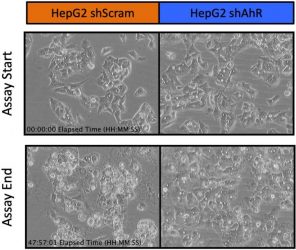Small molecule screens reveal new class of anticancer compounds
Posted: 12 May 2021 | Victoria Rees (Drug Target Review) | No comments yet
Two screening techniques were used by researchers to find anticancer compounds that target the aryl hydrocarbon receptor.


A team of Oregon State University, US, scientists has discovered a new class of anticancer compounds that effectively kill liver and breast cancer cells. The researchers describe the discovery and characterisation of the compounds in their study, designated as Select Modulators of AhR-regulated Transcription (SMAhRTs).
“Our research identified a therapeutic lead that acts through a new molecular target for treatment of certain cancers,” said Professor Siva Kolluri, whose lab the study was conducted in. The researchers identified the aryl hydrocarbon receptor (AhR) as a new molecular target for development of cancer therapeutics.
Specifically, they studied cells from human hepatocellular carcinoma, a common type of liver cancer and cells from triple-negative breast cancer, which account for about 15 percent of breast cancers with the worst prognosis.
“We focused on these two types of cancers because they are difficult to treat and have limited treatment options,” said Kolluri. “We were encouraged by the results because they are unrelated cancers and targeting the AhR was effective in inducing death of both of these distinct cancers.”
The team employed two small molecule screening techniques to discover potential SMAhRTs and identified a molecule – known as CGS-15943 – that activates AhR signalling and kills liver and breast cancer cells.


The images on the right show human hepatocellular carcinoma cells with the expression of the target AhR being killed upon treatment with the identified lead compound. The images on the left are human hepatocellular carcinoma cells without the target AhR [credit: Oregon State University].
The researchers also identified the AhR-mediated pathways that contribute to the anticancer actions of CGS-15943. Developing cancer treatments requires a detailed understanding of how they act to induce anticancer effects. The researchers determined that CGS-15943 increases the expression of a protein called Fas Ligand through the AhR and causes cancer cell death.
According to the team, these results provide exciting new leads for drug development, but they highlight that human therapies based on these results would not be available to patients for years.
“This is an exciting development which lays a foundation for a new class of anticancer therapeutics acting through the AhR,” said Edmond Francis O’Donnell III, the lead researcher.
The study was published in the journal Apoptosis.
Related topics
Drug Discovery, Drug Leads, Molecular Targets, Oncology, Screening, Small Molecules
Related conditions
Cancer, Liver cancer, Triple-negative breast cancer
Related organisations
Oregon State University
Related people
Edmond Francis O'Donnell III, Professor Siva Kolluri



